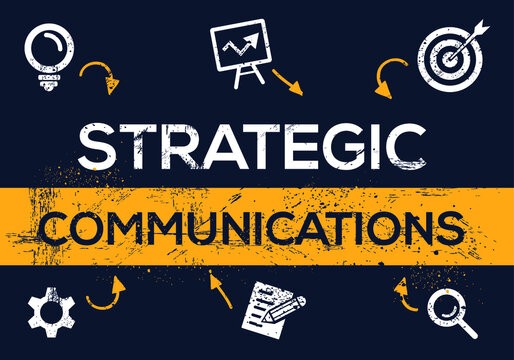By Deborah Asantewaah SARFO
In today’s competitive landscape, mastering the art of strategic communication has become important for any company that wants to excel and a must-have skill for that company that aspires to be the “go-to” and most trusted brand in any industry.
Strategic Communication (StratCom) involves delivering the right message to the right audience at the right time. It goes beyond disseminating messages to crafting them to resonate with your audience and amplify your brand’s values, mission, and credibility.
It is about telling the story of your brand that connects with your objectives and your audience as well. What defines strategic communications is careful planning, execution, and evaluation, allowing it to effectively reach and engage stakeholders, support decision-making, and achieve desired outcomes.
Brand reputation is the perception that customers, employees and partners have about a company. This can change over some time hence an incessant dissemination of a well-crafted message through an accessible channel at a given time is crucial to cementing the company’s reputation in the minds of people.
Moreover, in business where consumer perception can make or break a company, strategic communication has become an imperative in brand reputation. Now, leveraging the power of strategic communication for an effective and strong brand reputation begins with having a clear understanding of the brand’s identity; core values, mission and vision of the brand.
With this strong background information and defining what the brand stands for, companies can craft tailored messages that align with their identity and respond to the needs of their target audience. Strategic communication is, therefore, a game-changer and cornerstone to brand reputation. When communication is consistently aligned with these values, it reinforces the brand’s identity and fosters trust among its audience.
For instance, if a company brands itself as customer service-oriented, it must put in place measures to ensure that customer satisfaction is always prioritised. This alignment between values and communication means one thing; the brand’s message is authentic and credible.
Misalignment between a brand’s goal and behaviour can damage its reputation. Therefore, strategic communication should not end with conveying the right message but supporting it with real action. To build a strong and lasting reputation, businesses must always combine transparency and consistency when crafting messages.
Elements of strategic communication
Just as it requires some calculated steps to move from the ground floor of a storey building to the first floor, so it is significant to adopt specific approaches in delivering a message that will elevate the brand to a higher pedestal everyone would want to reckon with.
- Audience Understanding – the best way to get the eyeballs of your audience is to understand their tastes, preferences, and values
- Message Development – is crafting communications that are precise, succinct, and in line with the desired outcomes. Messages must inspire action, evoke the right emotions, and deliver the intended information.
- Consistent messaging – a company whose image is seen differently in different channels will never be taken seriously. Remaining consistent in what the company is and stands for on all social media platforms solidifies a business reputation in the public.
- Channel Selection – one key factor to consider when choosing a communication channel is the audience. The various platforms such as social media, websites, press releases, newsletters, events, and more. Each channel has its strengths and weaknesses, and selecting the right mix ensures maximum reach and impact.
- Feedback – quick response to customer’s enquiries and complaints from customers demonstrates a brand’s adaptability and respect for customer service.
Develop a strategic communication plan
Having a respected and highly-recognised brand does not take place in a vacuum, rather it thrives on developing a compelling strategic communication plan.
- Objective of the plan – It is important to have a specific or well-defined objective for the communication plan. To achieve your expected outcome these objectives must be Specific, Measurable, Achievable, Relevant and Time-bound (SMART).
- Situational analysis – conduct research to know the communication challenges in your industry and also analyse the internal and external factors that can negatively impact the communication plan.
- Audience analysis – Segment your audience into customers, employees, partners, stakeholders and others to craft a tailored message for each targeted audience.
- Specific message – After targeting and segmenting your audience, the next thing on the plan is to craft a specific message that will resonate with your audience. However, ensure that every message aligns with the company’s vision and prioritise engaging messages or content.
- Multi-channel approach – Based on the demographic and needs of your audience, select an effective mix of channels you will adopt in sending your message to them. When choosing, consider the strengths and weaknesses of each of the channels; emails, social media, press releases, events).
- Media relations – Build strong relationships with journalists to secure strong and positive news coverage of your company or business.
- Budget – Have an estimated cost you will incur in executing the plan and allocate a budget for every item on the plan.
- Evaluation and adaptation – While implementing the plan, continue to evaluate its effectiveness through metrics such as social media engagement media mentions, and website analysis and surveys. Consider how best you will implement all the outcomes of the plan.
In addition to the above, complement them with the right strategic communication tools and software such as Asana, a project management software, for effective execution of the communication plan, email marketing software to reach the external audience, social media to engage with the audience, Google Analytics to provide insights into audience engagement and intranet platform to boost communication with employees.
Consumers have a perception for every industry to counter the negative ones and tag yourself as a trusted brand, you’ve got to leverage strategic communication to tell the company’s story in a unique and compelling way.










